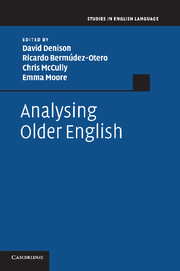Book contents
- Frontmatter
- Contents
- Figures and maps
- Tables
- Contributors
- General introduction
- Part I Metrics and onomastics in older English
- Part II Writing practices in older English
- Part III Dialects in older English
- Part IV Sound change in older English
- Part V Syntax in older English
- 16 Introduction to Part V
- 17 The status of the postposed ‘and-adjective’ construction in Old English
- 18 do with weak verbs in early Modern English
- References
- Index
16 - Introduction to Part V
Published online by Cambridge University Press: 05 December 2011
- Frontmatter
- Contents
- Figures and maps
- Tables
- Contributors
- General introduction
- Part I Metrics and onomastics in older English
- Part II Writing practices in older English
- Part III Dialects in older English
- Part IV Sound change in older English
- Part V Syntax in older English
- 16 Introduction to Part V
- 17 The status of the postposed ‘and-adjective’ construction in Old English
- 18 do with weak verbs in early Modern English
- References
- Index
Summary
Historical syntax is notoriously one of the late developers in philology, with morphological and phonological reconstruction making impressive advances long before syntax had much to show for itself. Historical syntax was largely synchronic, concerned as it often was with the description of patterns in one author or text or period. From the 1970s there was an outburst of syntactic work with a theoretical bent, galvanised in part by David Lightfoot’s famous attempt to use English modal verbs to bring diachronic syntax within the purview of Chomskyan grammar (Lightfoot 1974, 1979, etc.). This too could be synchronic, but increasingly it attempted diachrony as well, despite Lightfoot’s assertion that there was no formal connection between the grammars of different epochs (Lightfoot 1979: 142–9; Warner 1983: 189). The characteristic turn in this enterprise was to try to explain disparate surface changes as stemming from a single change in the underlying grammar – the more numerous and the more disparate the changes, the more impressive. This approach to linguistic theory was at the time aggressively modular, and syntax therefore had to be discussed and explained in isolation (with the possible exception of inflectional morphology). Semantics was not to be appealed to.
On another front, the Helsinki Corpus of English Texts, released in the 1990s, was the first systematically gathered historical corpus of English, and scholars began to make use of earliest and latest attestations as evidence of the birth or death of constructions, not always conscious of the limitations of a sample corpus. But with a reasonably sized corpus, one is tempted to count. Increasingly, that corpus and others that followed were mined for the relative frequencies of rival patterns.
- Type
- Chapter
- Information
- Analysing Older English , pp. 247 - 250Publisher: Cambridge University PressPrint publication year: 2011



